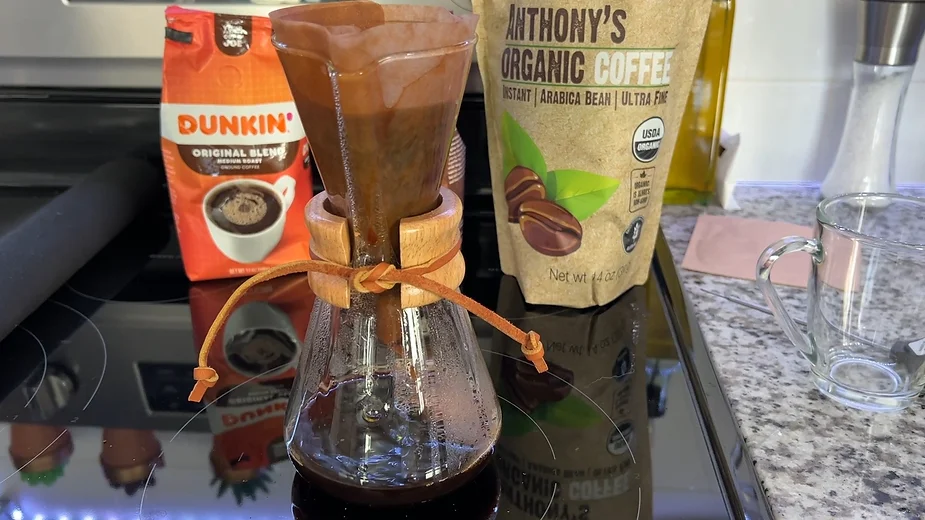Grab some organic dark chocolate with nuts and sea salt, and pour a tall glass of Cabernet Sauvignon, because wine is healthy again! We were amazed to find in our research that there are nutrients in certain types of chocolate, natural sugar, sea salt, red wine, and organic coffee that your body needs to function normally.
Sugar
Sugar makes us feel good because it activates the dopamine hormone. Although dopamine is widely recognized as the ‘pleasure hormone’ and is involved in addiction, it has lots of other important functions in the brain – being involved in everything from regulating movement, to the control of attention, to making decisions. Its effects depend on which of the brain’s pathways it is operating in.
Natural sugars will meet your craving, but each sugar molecule is encased with nutrients. Your body uses the nutrients with the sugar for good health. Natural or processed, the chemical makeup of sugar is always the same. Sugar found in its natural form, like in an apple, is encased with elements like calcium, phosphorus, and magnesium. So when you bite into an apple, you get a slew of elements bonded to C12 H22 O11. Cane sugar is also unprocessed and wrapped in other elements.
Processed sugar strips away what the industry likes to call “impurities.” Those impurities are other elements bonding with the sugar – even the good ones that help provide necessary nutrients and slow down your body’s absorption of sugar. Processed sugar is absorbed faster because sugar’s original bond has changed. A shot of processed sugar gives us quick energy, like if you drink a soda, but then a crash of tiredness comes.
Over thousands of years, our bodies have evolved to recognize natural sugar in fruits and unprocessed foods. When the sugar we eat is stripped of its “impurities,” the body must adjust to utilize this processed sugar. This brings on inflammation and pain causing havoc in your body, potentially resulting in high blood pressure, digestive issues, and headaches.
Can you eat too much sugar?
It’s not about how much sugar you eat. It’s all about the form of the sugar. Evolution has hardwired our bodies to process natural food bonds. Sugar, in its natural form and bond, has never been the enemy. Enjoy sugar options like raw cane, beet sugar, molasses, honey, stevia, coconut, monk fruit, and real maple syrup – the kind from an actual tree.
Eliminating processed white sugar from your diet could possibly keep thousands of people from getting type 2 diabetes. And forget about artificial sugars made in a laboratory. They give you no nutritional benefit, and case studies show it can cause an overgrowth of bad bacteria in your digestive system. Eliminating white and artificial sugars will result in healthier blood, alleviate much of your chronic pain, and ultimately strengthen all of your organs. Pasta, bread, yogurt, cereal, energy bars, salad dressing, instant oatmeal and even dried fruit can have added processed sugar. Check the labels.
SALT
Salt is about 40% sodium and 60% chloride. It flavors food and is used as a binder and stabilizer. It is also a food preservative, as bacteria can’t thrive in the presence of a high amount of salt. The most widely used salt, known as “table salt,” is extracted from underground salt deposits. It is heavily processed to remove impurities, which also removes important trace minerals. Table salt also often contains an anticaking agent such as calcium silicate to prevent clumps from forming. Most commercial table salt also contains iodine. That’s an entirely different story for another day.
Kosher salt is a coarsely grained salt named for its use in traditional Kosher food preparation. Kosher salt does not typically contain iodine but may have an anti-caking agent.
Sea salt is produced by evaporating ocean or sea water. It is also composed mostly of sodium chloride, but sometimes contains small amounts of minerals like potassium, zinc, and iron depending on where it was harvested. Because it is not highly refined and ground like table salt, it may appear coarser and darker with an uneven color, indicating the remaining impurities and nutrients. Unfortunately, some of these impurities can contain metals found in the ocean, including lead.
Himalayan pink salt is harvested from mines in Pakistan. Similar to sea salt, it is less refined and therefore the crystals contain small amounts of minerals including iron, which give it its pink color, calcium, potassium, and magnesium. This salt may also contain trace metals including lead, so use caution when sourcing this.
The human body requires sodium to conduct nerve impulses, contract and relax muscles, and maintain the proper balance of water and minerals. It is estimated that we need about 500 mg of sodium daily for these vital functions. For context, that’s about half a teaspoon, or the weight of a penny. Most Americans consume about 3400 mg of sodium every day, which contains far more than our bodies need.
Can I consume too much salt?
Too much sodium in the diet can be problematic. In some people, the kidneys have trouble removing excess sodium in the blood, so the body holds onto water to dilute the sodium. This can stiffen blood vessels, leading to high blood pressure, heart attack, and stroke. It can also cause calcium loss, some of which may be pulled from your bones, resulting in weaker bones more apt to break.
Salt comes out of your body in two ways – through urine and through perspiration. That doesn’t mean you need to add extra salt to your diet every time you pee or sweat. Under normal circumstances, plain water and a balanced diet will replenish your salts. Sports drinks are advertised as a good way to replace lost salts after working out. Sports drinks that contain electrolytes sound exciting, but are generally not necessary for rehydration, and may contain more processed sugar than you want in your diet.
Additional potassium intake can help relax blood vessels and excrete sodium while decreasing blood pressure. Our bodies need far more potassium than sodium each day, but the typical U.S. diet is just the opposite. Sea salt and Himalayan salts have traces of potassium. Table salt does not.
Here’s the rub. More recent research shows there may be benefits to consuming more than the official recommended daily allotment of salt. Sea salt and Himalayan salt is thought to improve sleep because it contains additional minerals and electrolytes for regulating hormones. Eating salt may help reduce stress. When rats are put in stressful situations, they choose to drink salty water rather than unsalted water. When wild rabbits were stressed, their sodium intake shot up too. The stress-reducing effects of salt in humans are not as well documented, but there is some evidence. A 2014 study found women whose diets were high in sodium were less depressed than other women. Male rats on high-sodium diets showed increased sperm counts. And in a 1991 experiment, men whose sodium intake was lowered to 2.4 grams a day complained of erectile dysfunction more often than those who consumed three grams a day.
There are a few ailments that can cause people to crave salt. People with adrenal insufficiency (Addison’s disease) experience acute salt cravings. It’s also possible that sodium aids growth, explaining why kids seem to gravitate to the salt shaker.
WINE
Red wine, in moderation, has long been thought of as heart healthy. Some studies show red wine might help prevent damage to blood vessels, reduce low-density lipoprotein (LDL) cholesterol (the “bad” cholesterol), and prevent blood clots.
Antioxidants in red wine called polyphenols may help protect the lining of blood vessels in the heart. A polyphenol called resveratrol is one substance in red wine that has been reported to possess many health benefit effects that are protective against age-related diseases.
The resveratrol in red wine comes from the skin of grapes used to make wine. Because red wine is fermented with grape skins longer than white wine, red wine contains more resveratrol. Simply eating grapes or drinking grape juice might be a way to get resveratrol without drinking alcohol. Red and purple grape juices may have some of the same heart-healthy benefits of red wine. But wine is so much more fun.
Peanuts, blueberries, cranberries, and some other red berries also contain resveratrol. It’s not yet known how beneficial eating these or other foods might be compared with drinking red wine when it comes to promoting heart health. The amount of resveratrol in food and red wine can vary widely.
Digging a little deeper, resveratrol is a phytoestrogen. Phytoestrogens are plant-based compounds that have a similar structure to estrogen, a hormone that is produced by the body. They have been found to be beneficial in combating symptoms and conditions caused by estrogen deficiency. This may be of particular benefit to premenopausal and postmenopausal women. Phytoestrogens may also play a role in fighting cancer, and maintaining bone density. Men need estrogen too – just not as much as women do. It’s essential for maintaining libido, erectile function, and making sperm.
CHOCOLATE
Once called the “drink of the gods” by the Mayan people, Chocolate comes from the seeds of the cacao pod, which grows on the cacao tree, native to the tropical rainforests of Central America where it has grown for thousands of years. The ancients would combine the seeds with heated water to create a prehistoric hot cocoa.
Chocolate also contains a small amount of the marijuana-like neurotransmitter called anandamide. Although this molecule can easily cross the blood-brain barrier, the levels in chocolate are probably too low to produce an effect on our mood by itself. It also contains some phytoestrogen compounds, a fact that may explain a recent series of reports showing that men who eat chocolate live longer than men who do not eat chocolate.
This may also explain why about 45 percent of women in the U.S. report that they have chocolate cravings, with a whopping 91 percent of female college students reporting regular cravings for it. And Researchers found that women in their fifties often develop a sudden strong craving for chocolate. The female desire for chocolate crosses all ages.
One of the great health effects of cocoa and chocolate is the antioxidant effect. The cocoa bean is rich in flavanols and polyphenols. A bar of dark chocolate contains as many antioxidants as a glass of red wine. Why not have both? Double down!
Chocolate is also a high potassium food. It is also low in sodium, making chocolate a great choice for people who need to regulate their sodium, and also provide the benefits of potassium to bone health, blood pressure, and cardiovascular health.
The purer and darker the chocolate, the greater your health benefits. Raw chocolate or minimally processed dark chocolate high in cocoa solids is healthier than milk chocolate and white chocolate. Dark chocolate has anywhere from 50 to 90 percent cocoa solids, while milk chocolate is typically 10 to 30 percent. White chocolate is pure cocoa butter and doesn’t offer you any health benefits.
Eating dark chocolate offers you a healthy mix of minerals, including:
- Magnesium
- Zinc
- Iron
- Phosphorus
- Copper
Clearly, there are many good reasons for men and women to eat chocolate to obtain its indescribably soothing, mellow, and yet euphoric effect.
COFFEE
Recent research provides strong evidence that drinking coffee actually has a variety of health benefits. Moderate coffee intake—about 2–5 cups a day—is linked to a lower likelihood of type 2 diabetes, heart disease, liver and endometrial cancers, Parkinson’s disease, and depression. It’s even possible that people who drink coffee can reduce their risk of early death.
Coffee is probably best known for that one natural stimulant — caffeine — that gives people energy and keeps them alert throughout the day. Caffeine binds on adenosine receptors, which normally make you feel sleepy, and reduces their depressive effects. But what might keep one person up all night may hardly affect another’s slumber. Caffeine metabolism varies widely.
It’s unlikely that caffeine itself is responsible for the health benefits. It’s more likely the hundreds of bioactive compounds found in the coffee bean. Coffee contains lots of polyphenols, which have been found to fight inflammation and protect against some diseases. Studies have suggested that some of the same reductions in diabetes and heart disease risk are associated with decaffeinated coffee, which means it’s not just the caffeine.
Experts find that coffee brewed with a paper filter is the preferred preparation method. Other methods of making coffee, including espresso, French press or boiled Turkish coffee are considered “unfiltered,” even if they’re strained by a metal filter. Unfiltered coffee is associated with higher rates of mortality, and can contain compounds called diterpenes that raise levels of “bad” cholesterol or LDL. They also advise not going overboard with added cream or sugar, as you’ll find in a Venti Java Chip Frappuccino with extra whipped cream, or a Dunkin’ caramel macchiato. We have a blog post on making healthy coffee here.
Not much is known about the effects of coffee on children, and caffeine could be harmful to pregnancies. Too much caffeine can also cause anxiety in people with panic or anxiety disorders.
Is coffee addictive? Maybe. It has a valid ICD-10 code for medical records and insurance claims called “Caffeine Dependence Syndrome.” Caffeine has clearly defined withdrawal symptoms, like headache, fatigue, trouble concentrating, and can lead to tolerance and cravings — but likely doesn’t accompany other hallmarks of substance abuse and dependence. I’ve kicked it a few times. Ironically it turns out some addictions, like coffee, might be good for you.
SOURCES:
Here is a list of helpful links along with excerpts from each one:
- https://pubmed.ncbi.nlm.nih.gov/20926118/ is a 2010 study that found that chocolate consumption was associated with a reduced risk of heart disease. However, the study was observational, so it cannot prove that chocolate caused the reduced risk of heart disease.
- https://www.ncbi.nlm.nih.gov/pmc/articles/PMC3074428/ is an article that discusses the potential health benefits of chocolate. The article states that chocolate contains antioxidants, which can protect cells from damage. It also contains flavanols, which can improve blood flow. Some studies have shown that chocolate can reduce the risk of heart disease and stroke. However, chocolate is also high in calories and fat, so it is important to consume it in moderation.
- https://www.washingtonpost.com/national/health-science/we-eat-a-lot-of-salt-but-scientists-say-there-are-good-reasons-for-that/2015/05/04/69ff7058-c806-11e4-a199-6cb5e63819d2_story.html is an article that discusses the reasons why humans crave and consume so much salt. The article states that salt is essential for human health, and that our craving for it is a natural instinct that helps us to survive. It also discusses the potential health risks of eating too much salt, and how to reduce our salt intake without compromising our health.
- https://www.ncbi.nlm.nih.gov/pmc/articles/PMC4854098/ states that coffee contains caffeine, which is a stimulant that can improve alertness and cognitive function. It also contains antioxidants, which can protect cells from damage. Some studies have shown that coffee can reduce the risk of type 2 diabetes, Parkinson’s disease, and Alzheimer’s disease. However, coffee can also increase anxiety and insomnia in some people.
- https://www.psychologytoday.com/us/blog/your-brain-food/201011/chocolate-the-good-the-bad-and-the-angry is an article that discusses the potential benefits and drawbacks of chocolate consumption. The article states that chocolate contains antioxidants, which can protect cells from damage. It also contains flavanols, which can improve blood flow. However, chocolate is also high in calories and fat, and it can trigger mood swings in some people.
- https://www.hopkinsmedicine.org/health/wellness-and-prevention/the-benefits-of-having-a-healthy-relationship-with-chocolate is an article from Johns Hopkins Medicine that discusses the benefits of eating chocolate in moderation. The article states that chocolate can improve mood, cognitive function, and heart health. However, it is important to eat chocolate in moderation, as it is high in calories and fat.
- https://www.cancer.org/latest-news/is-chocolate-good-for-you.html is an article from the American Cancer Society that discusses the potential benefits and drawbacks of chocolate consumption. The article states that chocolate contains antioxidants, which can protect cells from damage. It also contains flavanol






